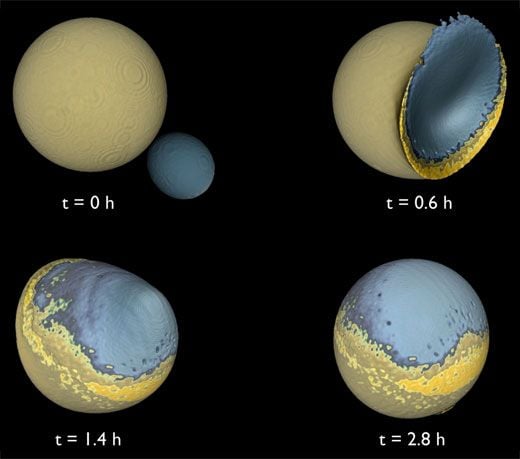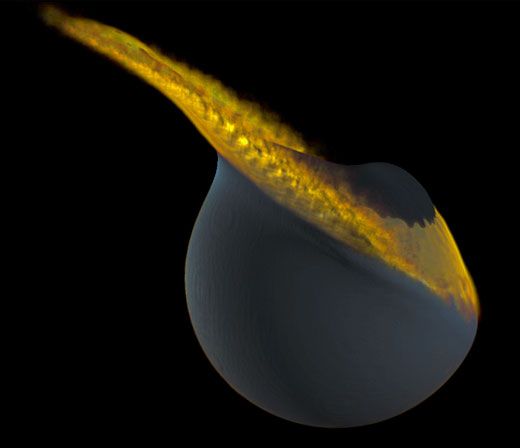Is Earth’s moon the product of a big splat as well as a big whack?
The second-moon theory.
/https://tf-cmsv2-smithsonianmag-media.s3.amazonaws.com/filer/Second-Moon-collision-FLASH.jpg)
As Erik Asphaug describes it, a spectacular collision over the skies of primordial Earth sounds like a bit from an old vaudeville act. “It’s the same physics as a pie in the face,” says Asphaug, a planetary scientist at the University of California at Santa Cruz whose new theory to explain the moon’s asymmetry was detailed last August in the journal Nature. The “face” in this act is the far side of the moon, while the “pie” was a smaller moon that splatted into it, a theory that may explain the far side’s thicker crust and the near side’s concentration of minerals.
The splat would have been the final step in a process that began with a much more violent collision between the newborn Earth and another planetary body about the size of Mars.
This “giant impact” theory says that the initial collision, referred to by some as the “big whack,” blasted Earth’s crust and part of its mantle into orbit. Over the next few thousand years, much of that debris coalesced to form the moon—or, as Asphaug and co-author Martin Jutzi see it, two or more moons. According to Asphaug, the scientists who have used computers to model the giant impact don’t make the moon as we know it today. “They make a debris disk,” he explains. “Over time [the modeled debris disk] gets clumpy, so errors start to accrue and the models get less accurate,” leaving room for the formation of more than one large body.
The idea of more than one moon is the latest in a series of tweaks and challenges to the giant impact theory. “I think that some version of the giant impact theory will survive, but I don’t think we have the right version yet,” says Jay Melosh, a planetary scientist at Indiana’s Purdue University and an early proponent of the original theory. “Many things fit very, very well, but we don’t have all the details.”
Before the Apollo missions, scientists debated three birth scenarios for the moon: It formed along with Earth, from the same primordial cloud of gas and dust; it was flung off the rapidly spinning, young Earth; or it formed elsewhere and as it ambled past Earth, it was captured by our planet’s gravity.
“None of these really worked, but here was the moon,” says William Hartmann, a senior scientist at the Planetary Science Institute in Tucson, Arizona. “But in the 1960s and ’70s, we were just beginning to realize that the planets formed by accretion”—smaller bodies ramming together to form larger ones. Hartmann and colleague Donald Davis proposed the giant impact model by combining the idea of accretion with the dynamics of the Earth-moon system and early analyses of the Apollo lunar samples, which showed a match between the composition of Earth’s crust and mantle and that of the moon’s.
“It was an absolutely outrageous idea, and many people simply didn’t consider it,” says Melosh. It caught on in the mid-1980s, though, and has reigned ever since.
Even so, the theory faces challenges. For example, a modern analysis of moonrocks collected by the Apollo 17 astronauts found that pockets of volcanic glass trapped inside the minerals had high concentrations of water. Yet the collision between Earth and the impacting body should have heated the debris to thousands of degrees, leaving almost no water in the new moon, says Hartmann.
“It looks like there is considerably more water embedded in the lunar material than people thought at the beginning,” he says. “A lot of water on Earth was vaporized and driven off as a gas into space. Could some of that have condensed on mineral grains that formed the moon? Could water have been driven into the minerals during or the impact? We don’t know. So I don’t think it rules out the big impact idea, but it might.”
The author of another recent study, however, says his findings support the theory. Analysis of a sample from Apollo 16 shows that it formed just 4.36 billion years ago, more than 100 million years later than the presumed age of the moon. “It would support the giant impact because there’s no way we know of to form the moon this late other than a giant impact,” says Richard Carlson, a staff scientist at the Carnegie Institution of Washington and a member of the team that conducted the study.
Hartmann agrees that the giant impact theory has room for the idea of two moons. “Maybe there was a time when you could have stood on the surface of Earth and seen two moons in the sky, or three or four” he says, “along with the smaller remnants of a ring. It’s not a radical perturbation of the theory.” Even better, it potentially solves some mysteries about the moon’s appearance and composition.
“The lunar far side has a bulge, like it’s wearing a yarmulke,” says Asphaug. The far side’s mountainous crust is about 30 miles thicker than the near side’s. In addition, the far side is less rich in certain minerals, like potassium and phosphorus, than the near side, almost as if something pushed them from far to near.
Last year a theory proposed that the bulge in the moon’s crust was created by the tidal pull of Earth’s gravity, just as the moon’s pull creates tides in Earth’s oceans. If that were the case, however, the lunar crust should show two bulges, Asphaug says. In our oceans, the moon’s gravity pulls more strongly on the near side of Earth, producing a bulge; inertia from Earth’s rotation produces a second one to balance the first.
Instead, Asphaug and Jutzi hypothesized that the bulge formed from the impact of a second, much smaller moon. The gentler, relatively slow collision would have squeezed some of the larger moon’s still partially molten crust from the far side to the near side, resulting in the trademark bulge and the movement of minerals.
While some computer models show the growing moons colliding quickly to form a single body, the Asphaug-Jutzi “splat” model requires the second moon to stick around for tens of millions of years to give it time to cool and solidify. This model assumes, therefore, that the second moon—and any other bodies—existed for all that time at gravitationally stable points, locked in synchronicity with the larger moon in orbit around Earth.
Eventually, Earth’s gravity acted as a brake, slowing the moons’ orbits, which in turn caused them to move farther away. At some point, the smaller moon would no longer be in a stable point, setting up the slow-speed merger. Within 100 million years, this gravitational jostling caused the cosmically slow splat that would have left Earth with the single moon we see today.
A pair of NASA spacecraft launched last September 10 could help planetary scientists evaluate the scenario. The Gravity Recovery and Interior Laboratory (GRAIL) mission, which will begin observations this January, will make the most detailed measurements to date of the moon’s gravitational field. “GRAIL will show us the thickness of the crust and help us see if our model holds up,” Asphaug says.
“All of the aspects—the timing, the dynamics—they all fit together. Whether it’s right…” Asphaug draws out the last word, then lets his voice trail off for a moment. “I’m cautious about it, but my job now is to be the attorney for the idea and defend it to the best of my abilities.” And, of course, hope that the pie-in-the-face idea doesn’t leave Asphaug with egg on his.
Damond Benningfield is a freelance science writer and radio producer in Austin, Texas.

